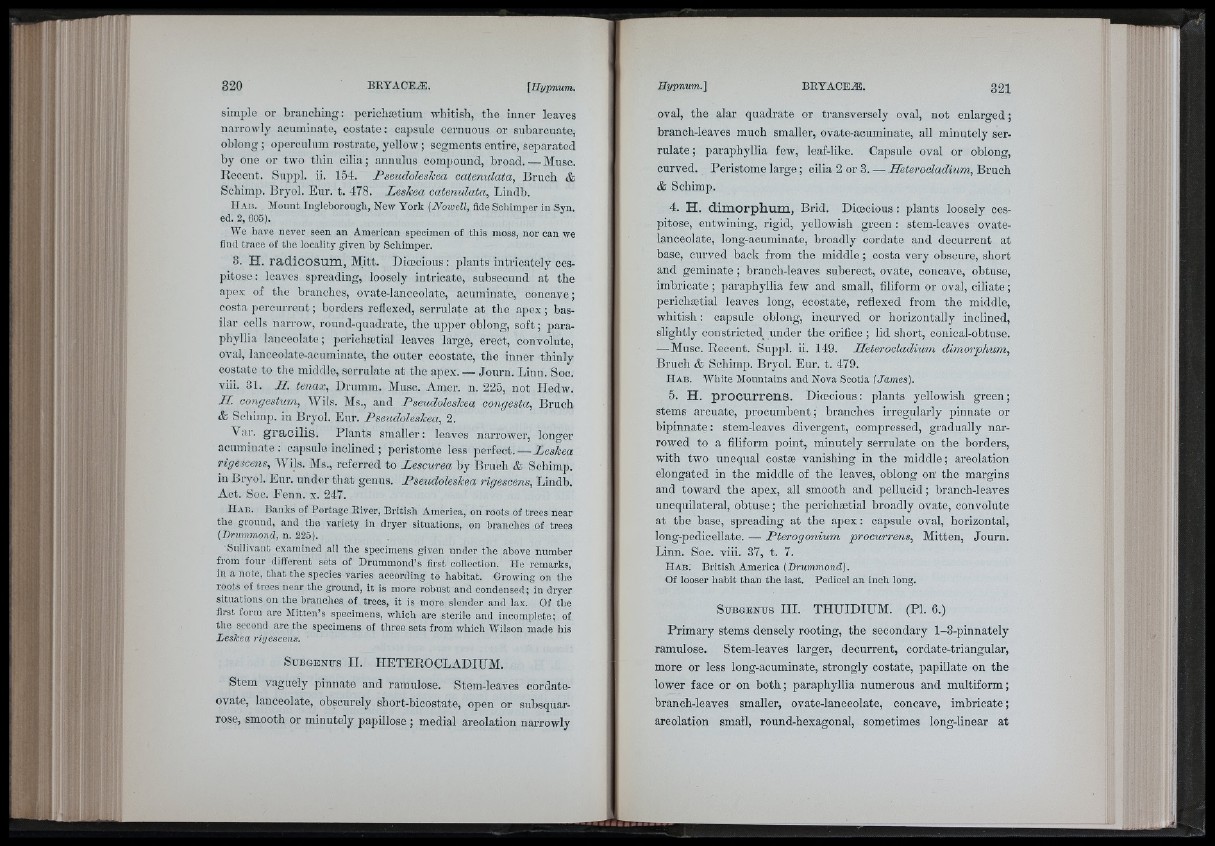
■ ’ i
; î
M .!
simple or branching: periohætium whitish, the inner leaves
narrowly acuminate, costate; capsule cernuous or subarcuate,
oblong ; operculum rostrate, yellow ; segments entire, separated
by one or two thin cilia; annulus comi)oimd, broad.—Muse.
Recent. Suppl. ii. 154. Pseudoleskea catenidata, Bruch &
Schimp. Bryol. Eur. t. 478. Leskea catenulata, Liudb.
I I a b . Mount Ingleborough, New York (Nowell, fide Schimper iu Syn.
ed. 2, 005).
AVe have never seen an American specimen of this moss, nor can we
find trace of tlie locality given by Scliimper.
3. H. rad ico sum , Mitt. Dioecious : plants intricately cespitose:
leaves spreading, loosely intricate, subsecund at the
apex of the branches, ovate-lanceolate, acuminate, concave;
costa percurrent ; borders reflexed, serrulate at the apex ; basilar
cells narroiv, round-quadrate, the upper oblong, soft ; paraphyllia
lanceolate ; perichætial leaves large, erect, convolute,
oval, Ianceolate-acumin,ate, the outer ecostate, the inner thinly
costato to tlie middle, serrulate at the apex. — Journ. Linn. Soo.
viii. 31. II. tenax, Drumm. Muse. Amer. n. 225, not Hedw.
II. congestum, AVils. Ms., and Pseudoleskea congesta, Bruch
Scliini]). in Bryol. Eur. Pseudoleskea, 2.
Var. g ra c ilis. Plants smaller: leaves narrower, longer
acuminate: capsule inclined ; peristome less perfect. — Leskea
rigcicens, AYils. Ms., referred to Lescurea by Bruch & Schimp.
in Bryol. Eur. under that genus. Pseudoleskea rigescens, Lindb.
Act. Soo. Fenn. x. 247.
H a b . Banks of Portage Eiver, British America, on roots of trees near
tiie ground, and tlie variety in dryer situations, on branches of trees
(Drummond, n. 225).
Snllivaiit examined all the specimens given under the above number
from four different sets of Drummond’s first collection. He remarks,
in a note, tliat tlie species varies according to habitat. Growing on the
roots of trees near the ground, it is more robust and condensed ; in dryer
situations on the brandies of trees, it is more slender and lax. Of tbe
first form are Mitten’s specimens, wliicli are sterile and incomplete; of
the second are tlie specimens of three sets from wliicli AA’ilson made his
Leslcea riijescens.
SuBGENus II. HETEROCLADIUM.
Stem vaguely pinnate and ramulose. Stem-leaves cordate-
ovate, lanceolate, obscurely short-bicostate, open or subsquarrose,
smooth or minutely papillose ; medial areolation narrowly
oval, the alar quadrate or transversely oval, not enlarged ;
branch-leaves much smaller, ovate-acuminate, all minutely serrulate
; paraphyllia few, leaf-like. Capsule oval or oblong,
curved. Peristome large ; cilia 2 or 3. — Iletei-ocladium, Bruch
& Schimp.
4. H. d im o rp h um , Brid. Dioeoious : plants loosely cespitose,
entwining, rigid, yellowish green : stem-leaves ovate-
lanceolate, long-acuminate, broadly cordate and decurrent at
base, curved back from the middle ; costa very obscure, short
and geminate ; branch-leaves suberect, ovate, concave, obtuse,
imbricate ; paraphyllia few and small, filiform or oval, ciliate ;
perichætial leaves long, ecostate, reflexed from the middle,
whitish : capsule oblong, incurved or horizontally inclined,
slightly constricted under the orifice ; lid sliort, conical-obtuse.
—Muso. Recent. Suppl. ii. 149. Ileterocladvum dimorphum,
Bruch & Schimp. Bryol. Eur. t. 479.
H a b . AVhite Mountains and Nova Scotia (James).
5. H. p ro c u rre n s . Dioecious : plants yellowish green ;
stems arcuate, procumbent ; branches irregularly pinnate or
bipinnate : stem-leaves divergent, compressed, gradually narrowed
to a filiform point, minutely serrulate on the borders,
with two unequal costæ vanishing in the middle ; areolation
elongated in the middle of the leaves, oblong on' the margins
and toward the apex, all smooth and pellucid ; branch-leaves
unequilateral, obtuse ; the perichætial broadly ovate, convolute
at the base, spreading at the apex ; capsule oval, horizontal,
long-pedicellate. — Pterogonium. procurrens. Mitten, Journ.
Linn. Soc. viii. 37, t. 7.
H a e : British America (Drummond).
Of looser habit than the last. Pedicel an inch long.
SuBGBNus HI. THUIDIUM. (PI. 6.)
Primary stems densely rooting, the secondary 1-3-pinnately
ramulose. Stem-leaves larger, decurrent, cordate-triangular,
more or less long-acuminate, strongly costate, papillate on the
lower face or on both; paraphyllia numerous and multiform;
branoh-leaves smaller, ovate-lanoeolate, concave, imbrioate ;
areolation small, round-hexagonal, sometimes long-linear at